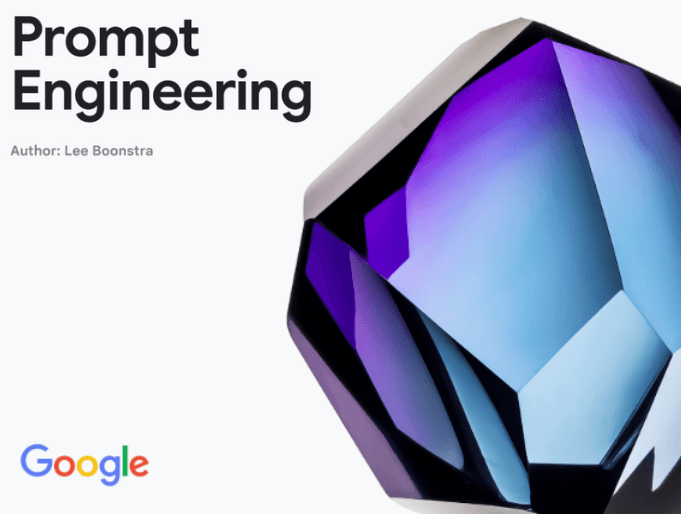
Discover the White Paper on Prompt Engineering: A Gold Mine for Mastering Generative AI
Looking to get the most out of large language models (LLMs) like those from Google, OpenAI, or Anthropic? white paper on prompt engineering, published by Google in collaboration with Kaggle in September 2024 (updated February 2025), is a must-read. This 69-page paper, authored by Lee Boonstra, demystifies the art and science of designing effective prompts to elicit accurate and useful responses from AI models. In this article, I explain why this white paper is a must-read and share real-life examples to give you a taste of what's in it.
Why is this white paper so special?
Prompt engineering is the art of formulating clear, contextual instructions so that LLMs produce exactly what you want. Whether you're a developer, marketer, researcher, or simply curious, this guide teaches you how to:
- Optimize your interactions with chatbots or tools like Google Gemini.
- Automate tasks such as code generation, content writing or data analysis.
- Reduce errors (the famous “hallucinations” of AI models).
Available for free on KaggleThis white paper combines theory, practical examples, and emerging trends. It's accessible to beginners while offering advanced techniques for professionals. Here's a sneak peek at what's inside, with examples taken directly from the document.
White Paper Highlights: Techniques and Examples
1. Zero-shot prompting: Getting results without examples
Zero-shot prompting involves giving clear instructions without providing examples. The white paper emphasizes the importance of precise wording.
Example (inspired by the white paper):
- Prompt : “Translate the following sentence into French with a formal tone: 'We are pleased to announce our new product launch.'”
- Expected result : “We are delighted to announce the launch of our new product.”
Trick : Be specific about tone, format, or context to avoid vague answers.
2. Few-shot prompting: Guiding AI with examples
For complex tasks, providing 1 to 3 examples (few-shot) helps the model understand your expectations.
Example (adapted from the white paper):
- Prompt :
“Classify the following comments as positive or negative.
Example 1: 'I love this product, it's amazing!' → Positive
Example 2: 'Too expensive for what it is.' → Negative
Comment: 'Delivery was fast and the product is great!' →?” - Expected result : Positive
Trick : Choose a variety of examples to cover different cases.
3. Chain-of-Thought (CoT): Making AI reason step by step
The CoT technique encourages the model to break down a complex problem into logical steps, ideal for calculations or analyses.
Example (taken from the white paper):
- Prompt : “Calculate how much paint is needed to paint a wall 5 m long and 3 m high, knowing that one liter covers 10 m². Explain your reasoning.”
- Expected result :
- Calculate the area: 5 m × 3 m = 15 m².
- Divide by the coverage: 15 m² ÷ 10 m²/litre = 1.5 litres.
Final answer: 1.5 liters of paint.
Trick : Add “Explain step by step” to enable reasoning.
4. Code Prompting: Generate and Debug Code
The white paper devotes a section to code generation, which is useful for developers.
Example (inspired by the white paper):
- Prompt : “Write a Python function that checks if a word is a palindrome. Include unit tests.”
- Expected result :
def is_palindrome(word): return word.lower() == word.lower()[::-1] # Unit tests assert is_palindrome("radar") == True assert is_palindrome("hello") == False print("Tests passed!")
Trick : Ask for comments in the code for clarity.
5. Self-Consistency: Reducing Mistakes
For creative tasks, running a prompt multiple times at high temperature and choosing the most consistent response improves reliability.
Example (adapted from the white paper):
- Prompt : “Come up with a slogan for an organic coffee brand. Relaunch 3 times and select the best one.”
- Possible results :
- “Pure flavor, naturally organic!”
- “Organic coffee, authentic taste.”
- “From bean to cup, 100% organic.”
Choice : The 3rd, for its punchy tone.
Trick : Use a temperature of 0.7 to 1 for more creativity.
Why read this white paper?
This guide doesn't just list techniques. It offers:
- Practical tips : How to adjust the temperature or top-p for more precise or creative responses.
- Varied use cases : From text generation to data analysis, including software development.
- A vision for the future : The authors explore multimodal prompts (text + images) and prompt automation via AI.
Whether you are a beginner or an expert, this document gives you the tools to fully exploit the potential of LLMs.
Dive into the subject with Vision AI
To go further, I highly recommend the video of AI Vision on YouTube, which dissects this white paper with infectious energy. Published in April 2025, it explores advanced techniques such as Chain-of-Thought, Tree of Thought, And ReAct, with concrete examples that show how AI can reason and act like a true autonomous agent. AI Vision explains why this document is considered a “bible” of prompt engineering and how it can transform your use of AI. Watch it now for a dynamic preview: AI Vision – Google Drops an AI Bomb.
How to take advantage of it?
- Download it : Go to Kaggle to get the PDF for free.
- Test the examples : Use platforms like Google AI Studio or Kaggle Notebooks to experiment with prompts.
- Share your feedback : Join the discussions on Reddit or X to exchange tips with the community.
In conclusion
The Prompt Engineering white paper is an essential resource for 2025, whether you're an AI enthusiast or a professional looking to optimize your tools. With its real-world examples, diverse techniques, and accessibility, it transforms the way we interact with AI models. Download it today and start creating killer prompts!
What prompting techniques have you tried? Share your experiences in the comments!
https://www.youtube.com/watch?v=vGg6mH7_GK8&t=300s
